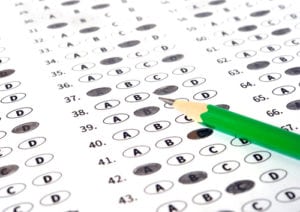What are performance-based assessments (PBA)? Here’s an example to help you understand PBAs.
Let’s think about verbs. Regardless of your level of interest in sentence structure, the word verb most likely brought one thing to mind: action. The physical act of doing something. Now, what verb in the following standard do you consider most significant? Develop a model to describe the cycling of water through Earth’s systems driven by energy from the Sun and the force of gravity.
If you picked develop, congratulations! That’s what the middle-school science student has to do in this case: create something to describe something else. Both the Common Core State Standards and the Next Generation Science Standards are all about action, regardless of the age of the student.
So, how does a student develop a model on a traditional multiple-choice assessment?
Chances are, this question made you pause a bit and think about it. Can a model be made by choosing A, B, C, or D? Kind of. You can definitely complete a model by selecting the correct answer. You can troubleshoot a model’s design in a similar way. But the actual development of a physical thing…not really!
.
Action-based standards call for a different method of assessment to determine a student’s level of mastery. The answer is performance-based assessments. Share on X
Characteristics of PBAs
According to Edutopia, performance-based assessments (PBAs) have the following qualities:
-
- Complex
- Authentic
- Driven by process and product
- Open-ended
- Time-bound
In addition, PBAs are created around a standard or multiple, closely related standards.
Download the handout: Benefits for Student Learning from Using Performance-Based Assessment
Although this may sound like a lot of elements woven together to create a test, it’s more natural than you might think. Having a student create a model of the water cycle out of words or images in order to show how it works makes more sense than picking out five important things about the water cycle and writing questions about them.

Consider a few other relationships between PBAs and today’s learning standards:
All aspects of the standard (or standards) can be assessed in one test
As long as you keep the standard at the heart of the assessment, using the performance-based method can provide a quick means of determining a student’s progress. This relationship boils down to the verb present in the standard: can the test-taker do what the standard is asking them to do?
Since assessing this way calls for backward design, it’s important to note that pupils should be aware of what will be asked of them on test day. If they are going to be presenting an argument from evidence around a topic, they need to understand that the research and writing they’ve done will be delivered as an oral presentation.

Rubrics build a bridge between the standard, the assessment, and the student’s level of mastery
How will you know if a model misses its mark, or a discussion leaves something to be desired? This is where a rubric is essential. Create the rubric as you create the assessment, or build it first and use it as a checklist while the test is created.
Rubrics also allow you to fine-tune instruction for after the test. If you compare all of the rubrics from an assessment, you’ll see a clear path to the aspects of the standard that everyone can demonstrate as well as those points that could use some additional work.
PBAs require a deeper level of thinking and application of knowledge
Think application, not regurgitation! A study by Professor Jim Mauch of California State University, Northridge found that PBAs tap into the real-world applications of the knowledge being tested. They also separate skills from standards concisely! Traditional tests demonstrate whether or not a student has knowledge of a standard, but have a tougher time showing if the student can apply that knowledge to a problem. Again, this pairs well with standards that are designed around action.
The ability to apply a skill also hits another high note in terms of a student’s level of college and career readiness. Now more than ever, school systems are taking a deeper look at the abilities of their students, and how they compare with what colleges and businesses are looking for. Pupils that can design a project around a topic from top to bottom outshine those who can simply state a few facts about the topic.
So, what does this all mean? Do you need to go out and stock up on Legos, glue sticks, and construction paper for your next assessment? Plan extra time for “making” rather than test-taking? Not necessarily! The beauty of PBAs is that they are what you make them.



